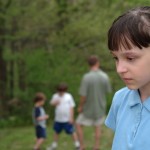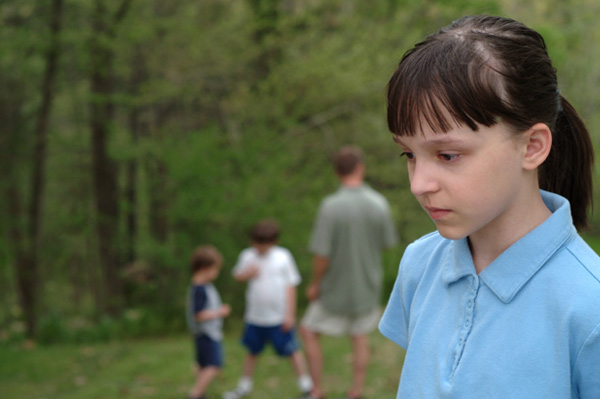2. Referral: Children are rarely self-referred: their parents or other adults decide the child needs help and seeks it out. The first task of a clinician working with children is to determine whether or not a problem actually exists. Intolerance, ignorance, and misconceptions on the part of the adult may be the reason for the referral. Indeed, parents’ referral of their child may be more a factor of their own emotional state. Other problems in referral are that certain behaviors may be overlooked. Parents, teachers, and other adults who refer a child for help, may underidentify children with certain disturbances because those disturbances are less salient or troublesome to them. For example: the child who withdraws from social contact will not be as salient as the child who disrupts class, and so may not be identified as needing help.
 3. Locus of Problem: This leads us to the question "Whose Problem Is It?" For example, the child's dependency means s/he is more likely to be scapegoated by other family members as the cause of problems within the family. In reality, then, the problem may not be the child's per se.
3. Locus of Problem: This leads us to the question "Whose Problem Is It?" For example, the child's dependency means s/he is more likely to be scapegoated by other family members as the cause of problems within the family. In reality, then, the problem may not be the child's per se.There are various ways of conceptualizing "the problem":
- Child-centered:Â The problem is the child's; there is something wrong with him/her.
– Dyadic model: The problem is in the nature of the child’s interaction with another person (eg: father). Various interaction patterns may be leading to problems for the child. A common faulty interaction pattern is the overreliance on coercion by a parent as a child management technique. Nevertheless, relationships tend to be reciprocal: behavior by one person tends to be reciprocated by the other. And so, coercion begets coercion.
– Psychological well-being of parents: Other problems may lie beyond the overt dyadic interaction, and have more to do with the cognitive and emotional problems other family members are having (Gordon & Davidson, 1981). For example:
– the mother may feel guilty about having a retarded son, and this adversely effects how she treats all her children.
– the father may be angry at having a child, perhaps unplanned for.
– parental psychopathology can effect the child’s behavior.
 In other words, the problem may have to do with the psychological well-being of each parent.
In other words, the problem may have to do with the psychological well-being of each parent.
– Family Systems model: Other problems experienced by the child may actually represent conflict and other difficulties elsewhere in the family, usually the marital relationship. For example: the parents may be angry at each other, but they take it out on the child. In a sense, the child’s problems may actually be a “symptom” of distress elsewhere in the family.
C. The Effects of Labelling: Given the dependent nature of children, and (especially for younger children) the fact that they are not really able to “speak for themselves” as it were, labelling a child with a diagnosis can have a profound impact on him/her; perhaps more so than with adults who are labelled. Labelling can lead to stigma/prejudice/discrimination exaggerate the severity of the child’s problem exaggerate the stability of the problem ignore environmental influences lead others to have negative expectations regarding the child (and so they treat the child accordingly…insuring a self-fulfilling prophecy, perhaps)
 Significance
Recognizing abnormal behavioral signs in children helps initiate early intervention when necessary. Problematic symptoms and behaviors worsen if left untreated. Intervention in children with abnormal behavioral patterns helps build confidence and self-esteem, and improves social interactions and academic success.
Function
Abnormal behavior in children serves to communicate other serious problems such as physical, emotional or sexual abuse. Children who have been abused often act out symptoms of distress, including physical aggression toward other children, eating disorders, sexual promiscuity and drug or alcohol abuse.Â
Types
 Fighting, bullying, threatening or intimidating others are forms of aggression that signal problems. Cruelty toward animals or people, vandalism and setting fires are all abnormal behaviors that are signs for alarm in children. Any indications of self-harm behavior, such as cutting on arms or legs are also considered abnormal. These behaviors can include suicidal or homicidal thoughts and actions or attempts. Refusing to eat, wetting or soiling oneself on a daily basis are warning signs and should be acknowledged.
Fighting, bullying, threatening or intimidating others are forms of aggression that signal problems. Cruelty toward animals or people, vandalism and setting fires are all abnormal behaviors that are signs for alarm in children. Any indications of self-harm behavior, such as cutting on arms or legs are also considered abnormal. These behaviors can include suicidal or homicidal thoughts and actions or attempts. Refusing to eat, wetting or soiling oneself on a daily basis are warning signs and should be acknowledged.
Identification
Observing a child closely for abnormal behavior, asking him questions regarding concerns and communicating regularly with teachers or caregivers provides further information about the child’s behavior. Gaining assistance from a mental health professional is recommended and facilitates interventions to treat abnormal behaviors.
Prevention/Solution
Preventing abnormal behavior requires prompt recognition of the problem and seeking help immediately. Behavioral therapy provided by a mental health clinician helps identify the problem and teaches appropriate coping skills to replace the maladaptive behaviors. Talking with a pediatrician, family practitioner or psychiatrist gives parents recommendations on whether or not medication is necessary.
